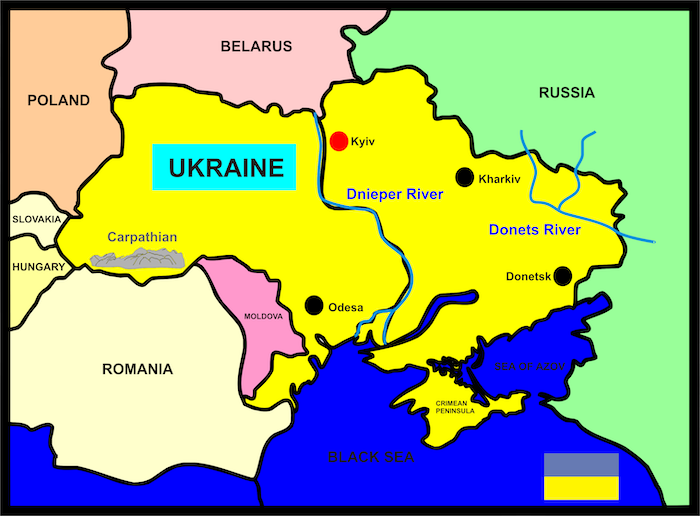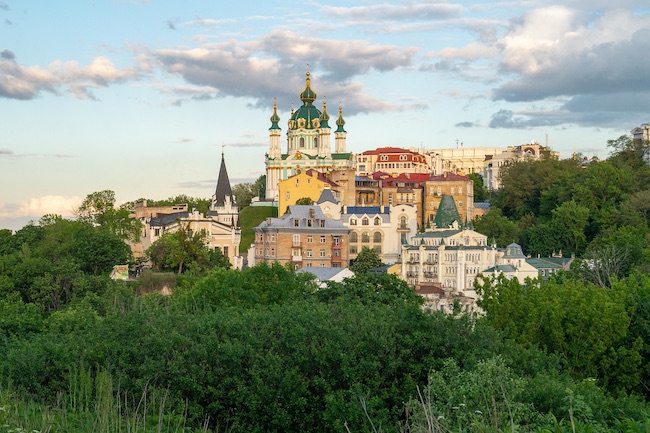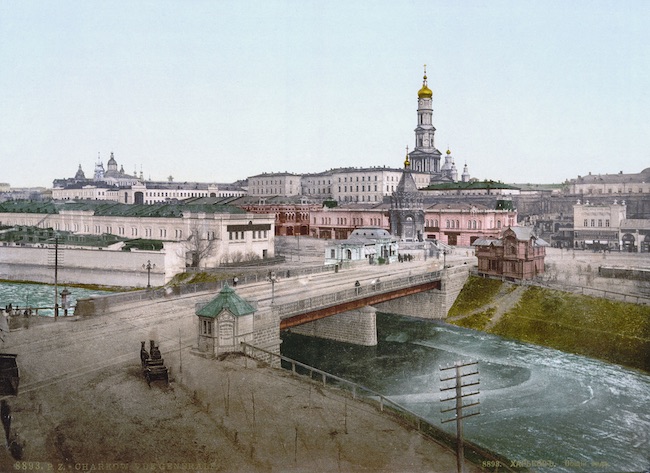Click on the map below to learn more
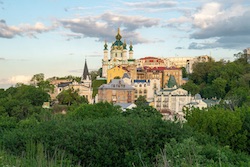 |
Kyiv, UkraineKyiv, also known as Kiev, is the capital and largest city of Ukraine. It is situated in the north-central part of the country on the banks of the Dnieper River. With a population of over 2.8 million people, Kyiv is one of the largest cities in Europe. The city has a rich history that dates back to the 5th century, and it has been a center of Slavic culture and civilization for centuries. The city was once ruled by the powerful Kievan Rus' state, and it served as an important center for trade and commerce. Over the years, Kyiv has been invaded and ruled by a number of different groups, including the Mongols, Lithuanians, Poles, and Russians. Despite its turbulent past, Kyiv has managed to preserve much of its historic architecture and cultural heritage. Visitors to the city can explore numerous landmarks and attractions, including the UNESCO-listed Kyiv Pechersk Lavra, a complex of monasteries and churches that dates back to the 11th century. The golden-domed St. Sophia's Cathedral, which was built in the 11th century, is also a must-see attraction for anyone interested in medieval architecture. Other popular landmarks in Kyiv include the 18th-century St. Andrew's Church, which offers stunning views of the city, and the 19th-century Mariyinsky Palace, which serves as the official residence of the President of Ukraine. For those interested in Soviet history, the Museum of the Great Patriotic War offers a fascinating look at Ukraine's role in World War II. In addition to its historic landmarks, Kyiv is also known for its vibrant nightlife and cultural scene. The city is home to numerous theaters, art galleries, and museums, as well as a thriving music and club scene. One of the best times to visit Kyiv is during the summer months, when the weather is warm and sunny and the city comes alive with festivals and events. The city's Independence Day celebrations on August 24th are particularly popular, featuring fireworks, parades, and live music performances. In recent years, Kyiv has also become a popular destination for digital nomads and remote workers. The city offers a low cost of living, high-speed internet, and a growing startup scene, making it an attractive option for those looking to work and live abroad.
|
|
|
|
 |
Kharkiv, UkraineKharkiv, located in the northeastern part of Ukraine, is the second-largest city in the country with a population of over 1.4 million people. It has a rich history, cultural heritage, and a modern outlook that make it a must-visit destination for travelers exploring Eastern Europe. The city dates back to the 17th century when it was founded as a military fortress. Over time, Kharkiv grew to become an important center for trade and commerce in Ukraine. During Soviet times, Kharkiv served as the capital of the Ukrainian SSR, and it played a significant role in the country's industrialization and modernization. Today, Kharkiv is a vibrant and modern city that offers a mix of historic landmarks, cultural attractions, and a thriving business scene. Visitors to the city can explore numerous landmarks and attractions, including the Freedom Square, which is one of the largest city squares in Europe. The square is home to the Derzhprom building, a towering example of Soviet Constructivist architecture that once served as the headquarters of the Soviet government. Another popular attraction in Kharkiv is the Kharkiv National University, which is one of the oldest and most prestigious universities in Ukraine. The university is known for its beautiful campus and impressive architecture, which includes a number of historic buildings that date back to the 19th century. For those interested in Soviet history, the Museum of the History of Ukraine in World War II offers a fascinating look at Ukraine's role in the war. The museum features exhibits on everything from military tactics and weapons to the experiences of ordinary citizens during the war. In addition to its historic landmarks and museums, Kharkiv is also known for its thriving cultural scene. The city is home to numerous theaters, art galleries, and museums, including the Kharkiv Opera House, which is one of the most important cultural institutions in Ukraine. Visitors to Kharkiv can also enjoy the city's parks and green spaces, including the Gorky Central Park of Culture and Leisure. The park offers a range of activities, including boating on the lake, walking and cycling on the numerous paths, and attending concerts and events at the open-air amphitheater. Finally, Kharkiv is also known for its business scene, with numerous international companies operating in the city. It is a hub for technology and innovation, with a growing startup scene that is attracting entrepreneurs from all over the world. |
|
|
|
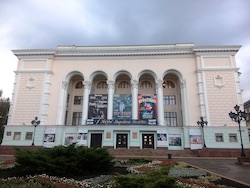 |
Donetsk, UkraineDonetsk, located in eastern Ukraine, is a city with a rich history and culture. The city has a population of over 1 million people and is known for its beautiful parks, museums, and cultural landmarks. Donetsk has a long history that dates back to the 17th century when it was founded as a small settlement. Over the years, the city grew to become an important center for coal mining and heavy industry in Ukraine. During the Soviet era, Donetsk played a significant role in the country's industrialization, and it was home to numerous factories and production facilities. One of the most popular attractions in Donetsk is the Donetsk Botanical Garden, which is one of the largest botanical gardens in Ukraine. The garden features over 10,000 plant species from all over the world, including rare and exotic varieties. Visitors can take a leisurely stroll through the gardens, enjoy the beautiful views, and learn about the different plants and flowers. Another must-see attraction in Donetsk is the Donetsk Regional Museum of Local Lore. The museum offers a fascinating look at the history and culture of the region, with exhibits on everything from traditional folk crafts to the city's industrial heritage. The museum also features a collection of archeological artifacts from the area, including tools and weapons from the Stone Age. Donetsk is also known for its beautiful parks, including the Park of Forged Figures, which features an impressive collection of metal sculptures. Visitors to the park can admire the intricate designs and learn about the history of blacksmithing in Ukraine. The city is also home to the Shcherbakov Park, which is one of the oldest parks in Donetsk and is famous for its picturesque lake. For those interested in Soviet history, the Palace of Culture named after Lenin is a must-visit destination. The building was constructed in the 1930s and served as a center for Soviet cultural and social events. Today, it is home to a theater, a museum, and a concert hall, and it is a popular venue for music and dance performances. In addition to its cultural landmarks, Donetsk is also known for its soccer team, FC Shakhtar Donetsk. The team has a strong following in Ukraine and has won numerous domestic and international titles over the years. The Donbass Arena, the team's home stadium, is one of the most modern and impressive soccer stadiums in Europe and is a must-visit destination for sports fans.
|
|
|
|
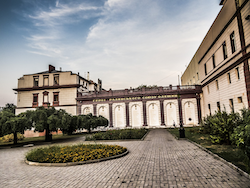 |
Odesa, UkraineOdesa, located on the Black Sea coast in southern Ukraine, is a city with a rich history, cultural heritage, and a vibrant atmosphere. With a population of over 1 million people, it is the third-largest city in Ukraine and a popular destination for tourists exploring Eastern Europe. The city was founded in the late 18th century and quickly grew to become an important center for trade and commerce in the region. Odesa has a diverse cultural heritage, with influences from Ukrainian, Russian, Jewish, and Greek cultures. Today, the city is known for its beautiful architecture, bustling nightlife, and stunning beaches. One of the most popular attractions in Odesa is the Potemkin Stairs, a grand staircase that leads down to the city's harbor. The staircase is famous for its appearance in Sergei Eisenstein's 1925 film, Battleship Potemkin, and it has become a symbol of the city. Visitors can climb the stairs and enjoy the panoramic views of the harbor and the Black Sea. Another popular attraction in Odesa is the Odesa Opera and Ballet Theater, which is considered one of the most beautiful opera houses in the world. The theater features a stunning neoclassical façade and a luxurious interior that includes a grand hall with a capacity of over 1,500 people. The theater hosts performances of opera, ballet, and classical music throughout the year. For those interested in history, the Odesa Archeological Museum offers a fascinating look at the city's past. The museum features exhibits on everything from ancient Greek and Roman artifacts to Ukrainian and Russian cultural artifacts. Visitors can learn about the history of the region and the different cultures that have shaped the city over the centuries. Odesa is also known for its beautiful beaches, including Arkadia Beach and Lanzheron Beach. These beaches offer crystal-clear water, white sand, and a range of activities, including swimming, sunbathing, and water sports. Visitors can also enjoy the beachside cafes and restaurants that offer delicious seafood and traditional Ukrainian cuisine.
|
|
|
|
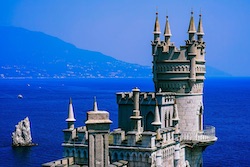 |
Black SeaThe Black Sea is a large body of water located between Eastern Europe and Western Asia, bordered by Ukraine, Russia, Turkey, Georgia, and Bulgaria. The sea has a rich history and is known for its beautiful beaches, diverse marine life, and strategic importance. The Black Sea is a popular tourist destination, particularly in the summer months when visitors come to enjoy the warm weather and beautiful beaches. The sea features over 2,000 kilometers of coastline, with popular beach resorts in Ukraine, Russia, Turkey, and Bulgaria. Some of the most popular beaches on the Black Sea include Golden Sands Beach in Bulgaria, Arkadia Beach in Ukraine, and Kemer Beach in Turkey. In addition to its beautiful beaches, the Black Sea is also known for its diverse marine life, which includes over 200 species of fish and numerous other sea creatures. The sea is particularly important for its sturgeon population, which is used for caviar production. However, overfishing and habitat destruction have led to a decline in the sturgeon population, and conservation efforts are underway to protect the species. The Black Sea also has a rich history, with numerous ancient civilizations thriving along its shores. The Greeks established colonies in the region as early as the 7th century BC, and the Byzantine Empire and Ottoman Empire both exerted influence in the region. During World War II, the Black Sea played a significant role in the conflict, with battles between German and Soviet forces fought along its shores. Today, the Black Sea is an important trade route for the countries that border it, with numerous ports and shipping lanes connecting the region to the rest of the world. The sea is also an important source of energy, with offshore oil and gas reserves that have attracted significant investment in recent years. However, the Black Sea faces numerous environmental challenges, including pollution from agricultural and industrial runoff, overfishing, and climate change. These issues have led to a decline in the sea's health, with dead zones and declining biodiversity becoming increasingly common. |
|
|
|
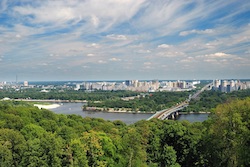 |
The Dnieper RiverThe Dnieper River (also spelled Dnipro or Dnepro) is one of the major rivers in Europe. It is the fourth longest river on the continent, stretching for a length of about 2,285 kilometers (1,420 miles) from its source in the Valdai Hills in Russia, through Belarus and Ukraine, and finally emptying into the Black Sea. The Dnieper River is an important transportation artery in Ukraine, and is also used for hydroelectric power generation, irrigation, and fishing. Several major cities, including Kiev (the capital of Ukraine), Zaporizhzhia, Dnipro, and Kherson, are located on its banks. The river has played a significant role in the history and culture of Ukraine. It has been referred to as the "Mother River" by Ukrainians, and has been celebrated in literature, art, and music. The Dnieper River was also a major trade route during the Middle Ages, and was an important link between the Vikings and the Byzantine Empire. Today, the Dnieper River continues to be an important resource for Ukraine, and is also a popular destination for river cruises and recreational activities such as boating and fishing.
|
|
|
|
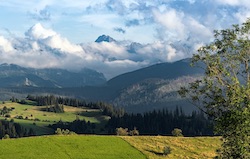 |
Carpathian MountainsThe Carpathian Mountains are one of Europe's most significant natural landmarks, stretching over 1,500 km through seven countries - Ukraine, Poland, Slovakia, Romania, Hungary, Serbia, and Austria. The mountains, which are considered to be the second-longest mountain range in Europe after the Scandinavian Mountains, are home to a vast range of flora and fauna, as well as a diverse mix of cultures and traditions. The Carpathian Mountains offer breathtaking scenery, with jagged peaks, deep gorges, and pristine forests. The highest peak, Gerlachovský štít, located in the High Tatras of Slovakia, rises to an elevation of 2,655 meters (8,710 feet). The Carpathians are also rich in mineral resources, including oil, natural gas, coal, and metals. The Carpathian Mountains are not only a natural wonder but also a significant cultural and historical site. The Carpathian region is home to a diverse mix of ethnic groups, including Ukrainians, Poles, Slovaks, Romanians, Hungarians, and Rusyns, each with their unique language and culture. The Carpathians have been inhabited since prehistoric times, and evidence of early settlements and ancient fortifications can still be found in the mountains. The Carpathian Mountains have also been an important trading route since ancient times, with salt and other valuable resources transported along the mountain passes. In the Middle Ages, the Carpathians were part of the Kingdom of Hungary and served as a defensive barrier against the Ottoman Empire. The mountains were also a popular destination for hunting and hiking for wealthy aristocrats in the 19th century. Today, the Carpathian Mountains are a popular destination for outdoor enthusiasts, offering opportunities for hiking, skiing, and other adventure activities. The region is also home to many traditional crafts and cultural events, including folk music and dance festivals, and artisanal markets. However, the Carpathian Mountains are facing many environmental challenges, including deforestation, overgrazing, and climate change. These issues threaten the unique biodiversity and cultural heritage of the region, and efforts are being made to protect and preserve the Carpathians for future generations. |
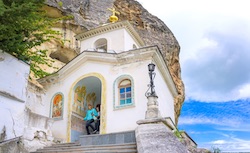 |
Crimean PeninsulaThe Crimean Peninsula is a piece of land located in the Black Sea that has been the focus of much attention and controversy over the past few years. This region has a long and complex history, having been part of different empires and countries throughout its existence. Today, the Crimean Peninsula is a territory that is disputed between Russia and Ukraine, with each country claiming sovereignty over the area. The Crimean Peninsula has been inhabited for thousands of years, and it has been the site of many important events throughout history. It was once part of the Greek colonies, and later became a part of the Roman Empire. The Crimean Peninsula has also been under the control of the Ottoman Empire, the Russian Empire, and the Soviet Union. In 1954, the Crimean Peninsula was transferred from the Russian Soviet Federative Socialist Republic to the Ukrainian Soviet Socialist Republic, which was a part of the Soviet Union at that time. This move was seen as largely symbolic since both Russia and Ukraine were part of the same country. In 2014, however, the situation changed dramatically. Protests broke out in Ukraine, leading to the ousting of the country's pro-Russian president, Viktor Yanukovych. Following Yanukovych's removal from power, a referendum was held in Crimea, which resulted in the majority of voters supporting the region's annexation by Russia. This move was met with international condemnation and led to the imposition of economic sanctions against Russia by the United States and the European Union. Since then, the Crimean Peninsula has been under Russian control, with the Russian government asserting its sovereignty over the region. Ukraine, however, continues to claim sovereignty over the area, and the dispute remains unresolved. The Crimean Peninsula is a significant geopolitical and strategic location, as it gives access to the Black Sea and the Mediterranean. It is also an important tourist destination, known for its stunning landscapes, warm climate, and cultural heritage. The region is home to many historic sites, including the ancient Greek colony of Chersonesus, the medieval fortress of Sudak, and the Khan's Palace in Bakhchysarai. Despite the region's tourism potential, the annexation of Crimea by Russia has had negative impacts on the local economy. The annexation has led to a decline in tourism, as many foreign visitors are hesitant to travel to a region that is still in the middle of a territorial dispute. Additionally, the economic sanctions imposed on Russia have had a negative impact on the region's economy. |
Kyiv, Ukraine |
|
| Population: | 43,700,000 (23rd in the world) |
| Area: | 233,026 sq. miles |
| Capital City: | Kyiv |
| Largest City: | Kyiv |
| Currency: | Euro |
| Official Language: | Ukraine Hryvnia |
| GDP (Gross Domestic Product) | $153 Billion (51st) |
| Back to Map | |
Kharkiv, Ukraine
|
|
|
|
 |
|
The flag of Ukraine is a symbol of the country's national identity, history, and values. The flag consists of two horizontal bands of equal width, with the top band being blue and the bottom band being yellow. The flag's dimensions are a ratio of 2:3, with the width being twice the height. The blue and yellow colors of the Ukrainian flag have a long and rich history, dating back to the medieval period. The colors are said to represent the blue skies and yellow fields of Ukraine, and have also been associated with the country's Coat of Arms, which features a golden trident on a blue shield. The Ukrainian flag's design has undergone several changes over the years. The blue and yellow colors were first used together in the 19th century, during the Ukrainian national revival movement, which sought to promote Ukrainian culture and identity. The first official use of the blue and yellow flag was in 1917, during the Ukrainian People's Republic, which was a short-lived state that emerged after the collapse of the Russian Empire. The flag was then adopted as the national flag of Ukraine after the country gained independence from the Soviet Union in 1991. Since then, the flag has become a symbol of Ukrainian national identity and has been widely used at official events and ceremonies, as well as by ordinary citizens. The colors of the Ukrainian flag have also taken on symbolic meanings beyond their association with Ukraine's natural landscape. The blue color is often seen as representing freedom, while the yellow is associated with prosperity and hope for a better future. The colors also have religious connotations, with blue being associated with the Virgin Mary, and yellow being associated with the golden-domed churches that are a common sight in Ukraine. Back to Map |
|
